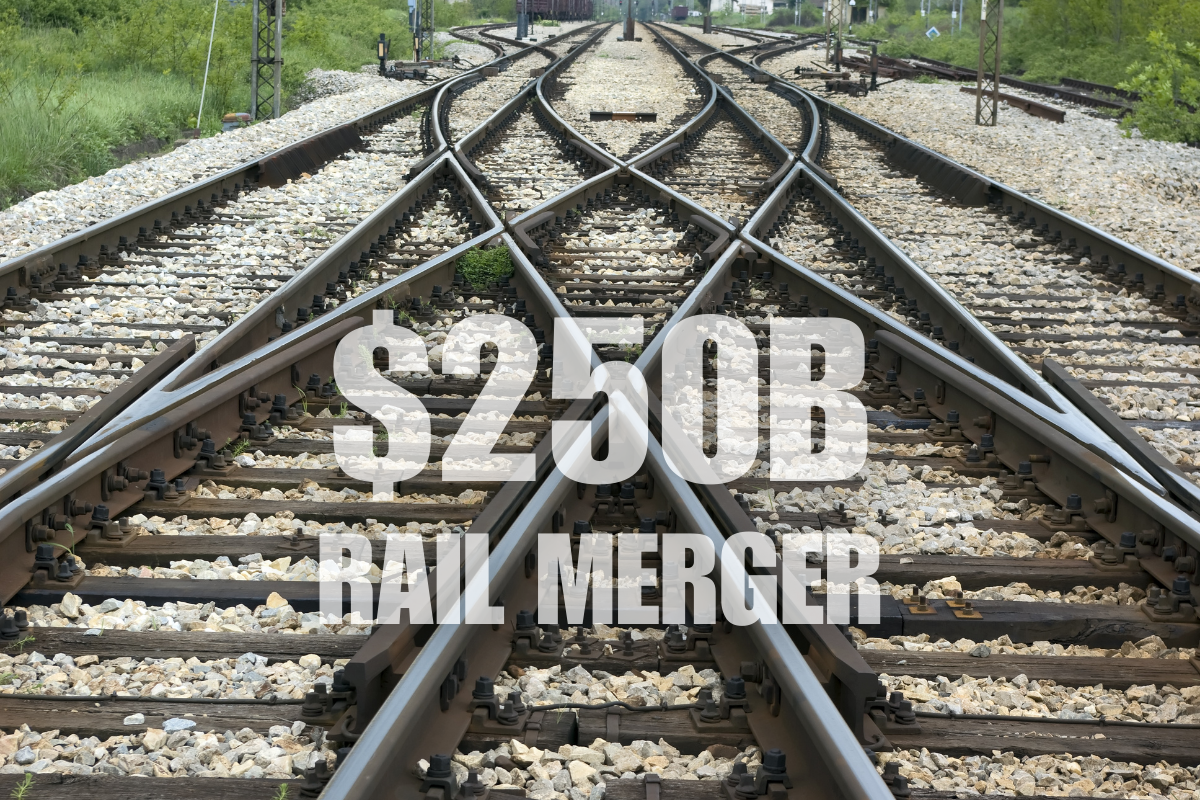In July 2025, the logistics world witnessed a seismic shift with the announcement of a $250 billion rail merger between Union Pacific and Norfolk Southern. This created the first transcontinental freight railroad in the United States. Spanning 43 states, connecting over 100 ports, and covering 52,000 miles of track, this historic deal is more than a corporate consolidation. It’s a bold step toward U.S. reindustrialization. As the nation doubles down on domestic manufacturing and supply chain resilience, this merger promises to tackle longstanding bottlenecks, enhance efficiency, and reshape the logistics landscape. Let’s explore how this mega-merger is set to transform the industry and what it means for logistics professionals, with insights from upcoming discussions at CSCMP EDGE 2025 (October 5-8, National Harbor).
The Union Pacific-Norfolk Southern merger, valued at over $250 billion, is a landmark event in North American rail freight. The deal creates a coast-to-coast network that eliminates costly and time-consuming interchanges, streamlining freight movement across the continent. The U.S. rail freight network is already considered the largest, safest, and most cost-efficient globally. It covers nearly 140,000 route miles and generates $80 billion annually. This merger amplifies those strengths. The combined entity is poised to handle 53% of its volume through intermodal transport, a critical component for modern supply chains reliant on seamless port-to-inland connectivity.
This rail merger comes at a pivotal moment. The push for U.S. reindustrialization, driven by policies encouraging domestic manufacturing, nearshoring, and reduced reliance on global supply chains, requires robust logistics infrastructure. The new transcontinental railroad directly supports this by connecting key manufacturing hubs, ports, and distribution centers across 43 states. For instance, the Port of Los Angeles, a top U.S. container port, is expected to benefit significantly, with its executive leadership already touting new market opportunities enabled by the merger.
Tackling Supply Chain Bottlenecks
One of the rail merger’s most immediate benefits is its potential to address supply chain bottlenecks, a persistent challenge for logistics professionals. By creating a single-line network, the merged railroad reduces the need for cargo transfers between carriers, which often cause delays and increase costs. CEOs of Union Pacific and Norfolk Southern have emphasized that eliminating interchanges will make rail a more attractive option for shippers, particularly in the nation’s midsection, where congestion has historically slowed freight movement.
The Surface Transportation Board (STB), which oversees rail mergers, has introduced resource guides to ensure this deal prioritizes public interest, including service reliability and competition. At CSCMP EDGE 2025, experts are expected to discuss how this merger could set a precedent for addressing bottlenecks through infrastructure consolidation. Sessions on supply chain optimization will likely explore how the expanded network can reduce dwell times at ports and improve delivery predictability, critical for just-in-time manufacturing.
Boosting Domestic Manufacturing
The merger aligns closely with the U.S. reindustrialization agenda, which seeks to revitalize domestic manufacturing to counter global supply chain vulnerabilities exposed during recent disruptions like the COVID-19 pandemic and Red Sea conflicts. By connecting over 100 ports to manufacturing hubs in the Midwest, Southeast, and West, the new railroad facilitates the efficient movement of raw materials and finished goods. This is particularly impactful for industries like automotive, electronics, and consumer goods, which rely on timely deliveries to maintain production schedules.
For example, the merger enhances rail access to industrial heartlands like Ohio, Michigan, and Texas, where manufacturing is resurging. A recent FreightWaves report noted that intermodal provider Hub Group strongly supports the merger, citing its potential to streamline connections between ports and factories. At CSCMP EDGE 2025, panels on reindustrialization will likely highlight how this rail network supports “Made in America” initiatives, reducing dependence on overseas suppliers and fostering economic growth.
Challenges and Concerns
Not everyone is on board with the merger. Shippers have raised concerns about potential rate hikes and service issues due to the consolidation of 52,000 miles of track under one entity. Canadian National, a rival railroad, has advocated for “collaborations” rather than mergers, suggesting a less centralized approach to improving rail efficiency. Additionally, an activist investor targeting CSX, another Class I railroad, signals ongoing scrutiny of rail consolidations, with potential ripple effects on competition.
The STB’s stringent merger rules, updated in 2001, require applicants to demonstrate public benefits and enhance competition where necessary. The Union Pacific-Norfolk Southern deal includes commitments to service reliability plans and competitive enhancements like reciprocal switching arrangements. CSCMP EDGE 2025 will feature discussions on regulatory oversight, with experts analyzing how the STB balances these concerns against the merger’s economic benefits.
Broader Supply Chain Implications
The merger’s impact extends beyond rail to the broader supply chain ecosystem. At CSCMP EDGE 2025, logistics leaders will explore how this deal influences intermodal transport, port operations, and last-mile delivery. For instance, the merger’s ability to connect 100+ ports strengthens the U.S.’s position in global trade, particularly as tariffs (effective August 7, 2025) disrupt import flows from countries like Mexico and Canada. Logistics firms may need to recalibrate strategies, leveraging the new rail network to offset tariff-related costs.
Additionally, the merger supports sustainability goals, a hot topic at CSCMP EDGE. Rail is inherently more fuel-efficient than trucking, and a consolidated network could reduce emissions by shifting freight from road to rail. Sessions on ESG (Environmental, Social, and Governance) strategies will likely highlight how railroads are aligning with net-zero targets, offering insights for logistics professionals aiming to green their operations.
What’s Next for Logistics Professionals?
For logistics managers, the Union Pacific-Norfolk Southern merger is both an opportunity and a call to action. Here are three actionable takeaways:
- **Optimize Intermodal Strategies**: Leverage the expanded rail network to integrate intermodal transport into your supply chain, especially for long-haul freight. Collaborate with providers like Hub Group to explore new routing options.
- **Monitor Regulatory Developments**: Stay informed about STB rulings and potential service disruptions during the merger’s integration phase. Attend CSCMP EDGE 2025 to hear directly from regulators and industry leaders.
- **Align with Reindustrialization Trends**: Partner with manufacturers relocating to the U.S. to capitalize on the merger’s enhanced connectivity. Use data analytics to identify optimal distribution points within the new network.
Join the Conversation at CSCMP EDGE 2025
The implications of this $250 billion rail merger will be a focal point at CSCMP EDGE 2025, held October 5-8 at National Harbor, Maryland. This premier supply chain conference will feature sessions on rail logistics, reindustrialization, and supply chain resilience, with thought leaders from Union Pacific, Norfolk Southern, and other key players. Register at (www.cscmpedge.org) to dive deeper into how this merger shapes the future of logistics.
A Critical Perspective
While the merger promises efficiency gains, it’s worth questioning the long-term trade-offs. Will reduced competition lead to higher rates for shippers? Could integration challenges create new bottlenecks during the transition? The logistics community must remain vigilant, ensuring the merger delivers on its promises without compromising service quality or affordability. Engaging with platforms like CSCMP EDGE will provide the insights needed to navigate these uncertainties.
The Union Pacific-Norfolk Southern merger marks a pivotal moment for U.S. logistics, aligning with the broader push for reindustrialization. By enhancing supply chain efficiency, reducing bottlenecks, and supporting domestic manufacturing, this deal could redefine how goods move across the nation. As we look to 2025, logistics professionals must seize this opportunity to innovate and adapt, ensuring their operations thrive in this new era of connectivity.
At TOP Worldwide, we understand that major industry shifts (like the Union Pacific and Norfolk Southern merger) can open new opportunities for smarter, more efficient freight strategies. Whether you need drayage services at key ports, expedited freight solutions, or complete supply chain optimization, our team is ready to help you navigate this new era of logistics. Let us connect your business to the capacity and expertise you need to stay ahead. Contact us today to learn how TOP Worldwide can move your freight forward.
*Sources: FreightWaves, Surface Transportation
 Jeff Berlin
Jeff Berlin
is the Chief Operating Officer of E.L. Hollingsworth & Co. and serves as the Senior Operations Executive for TOP Worldwide and Native American Logistics. With over 30 years of experience leading logistics and trucking companies, he brings deep industry expertise to his role. Jeff is also a CDL-A driver and a private pilot. Contact Jeff at jberlin@elhc.net.


